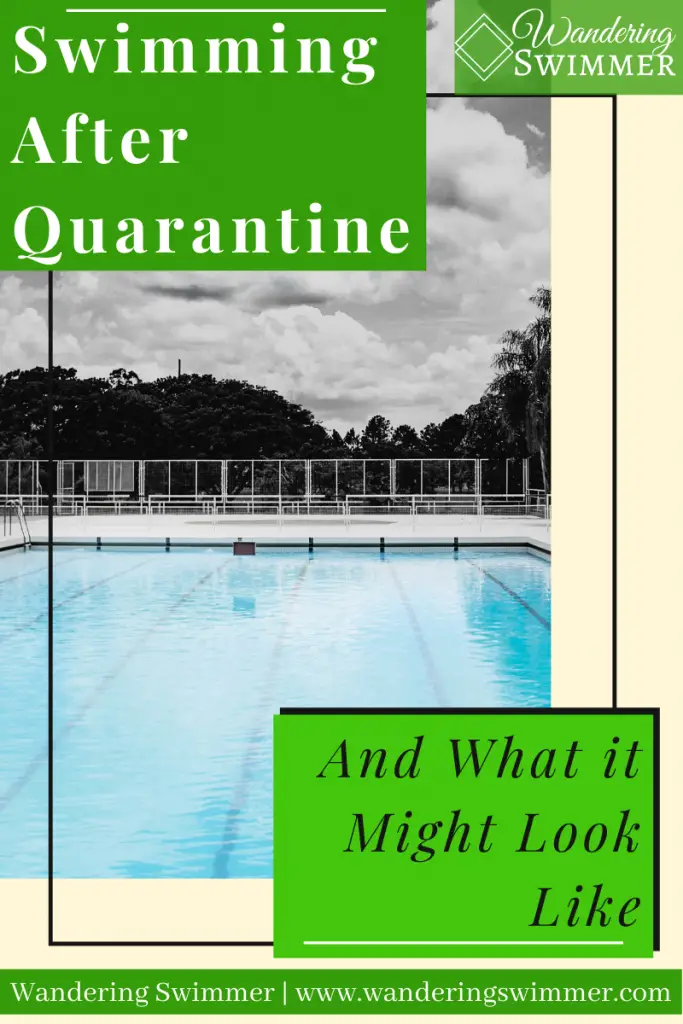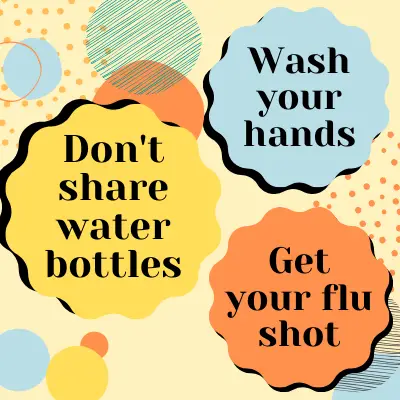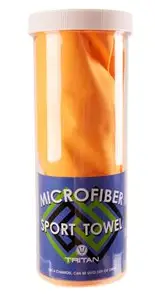As restrictions and quarantine rules lift, swimmers have anxiously started to wonder when the pools will open again. And wondering what swimming after COVID and quarantine might look like.
For most, public pools will probably open last compared to other areas.
And while the chances of COVID spreading through pool water remain low, it’s the surrounding people and surfaces that are the biggest danger.
USA Swimming has already released COVID swimming and facility guidelines as some areas open again. For teams ready and able to return to practice, these guidelines offer a glimpse at what swim practice might look like in this time of COVID and social distancing.
We don’t know and can’t say for certain what the future will hold for swimmers and the sport of swimming. But we can try to understand what swimming after COVID and quarantine might look like.
Disclaimer: These are only my opinions, thoughts, and observations contained in this post. They are provided only for informational purposes and shouldn’t be used or considered as medical advice. I’m not a doctor or medical practitioner. I encourage you to speak with your doctor, health care provider, or coach before returning to the water or training.
Disclosure: This post may contain affiliate links, meaning I earn a small commission at no cost to you if you purchase something through one of my links. As an Amazon Associate, I earn from qualifying purchases. Please check out my disclosure page for more information.

Follow Guidance From Public Health Officials
The guidelines set by the CDC and USA Swimming urge individuals to maintain a minimum of 6 feet for social distancing. This includes not just within the pool and dryland areas but also on the deck and outside the facility.
Both organizations also urge individuals to:
- Continue washing their hands
- Sneezing/coughing into the crook of the elbow
- Quarantining yourself if you display symptoms
- Going into quarantine if you have been in contact with someone who tested positive for COVID/showed symptoms
A tip specific to swimmers: Remember to wash your hands just before you get into the pool. Especially if you’re coming straight from dryland.
Most swimmers, including myself, will touch their faces as they put on goggles and caps. Washing your hands directly before putting on your goggles can help reduce the chance of infection when you touch your face.

Swimmers in the Pool
The days of crowding 5+ swimmers into a 25 yard/meter lane are probably over. At least for the next year or so.
Instead, swimmers might find themselves limited to about 4 swimmers per lane.
Two staggered at one end, with one at the wall and one by the flags. And two others at the opposite end. Doing so helps get the maximum number of swimmers in the pool, while still following social distancing.
USA Swimming has provided several different models that coaches can use based upon pool size. These models help show where each swimmer should stay in the lane during practice. At least when not swimming!
Another consideration would be to stagger when each lane starts a set.
Related article: How Swim Teams can Train During COVID
Yes, different intervals and rest breaks might make this challenging. But it enables different parts of the pool to be at rest while others swim.
An example would be that the odd lanes start the set first and the even lanes will start shortly after.
Alternating lanes will allow for proper social distancing and enables swimmers to race with the swimmer ‘next’ to them.
Ideal? Maybe not. But if it works and still allows everyone to swim in a healthy and safe manner, it might be an option!
Locker Rooms
Following quarantine and to keep with social distancing, locker room facilities, such as showers and changing areas, will probably remain closed. Especially for those who only have small locker rooms available to them.
To adjust for this, swimmers coming back after quarantine will have to arrive with their swimsuit already on. And leave the same way. Most coaches won’t allow swimmers to change and shower at the pool anymore.
For some swimmers, this will provide a challenge. Some, myself included, need to shower and change before going to school or work in the morning.
Going to practice from school or work though will also provide a bit of a challenge. It might not be easy for some to find a bathroom to use for changing if you can’t change at the pool.
Afternoon practices are a bit easier since you usually go straight home after practice. One thing to remember is to keep an extra towel with you for the drive home. Either in your bag or the car itself.
This way, you’re not ruining the seats of your vehicle with a wet towel.
In cases like this, a microfiber towel or shammy will work well! Use one of these to dry off directly after practice. This will save your towel for the drive home in addition to saving space in your bag 😉
Related article: 5 Reasons to Own a Shammy
For the winter months, consider using a parka if you can’t use the locker rooms. This will help keep you warm right after your practice. And has the added benefit of keeping your car seats dry too.
Consider Arena’s Team Line Parka if you have trouble staying warm. Or, a parka from Sporti if you don’t need as much warmth

Dryland Might be Done in Shifts
Dryland presents its own unique challenges for swimmers. For teams with a large space for dryland, it’s easier to maintain social distance.
Those with smaller space though might find themselves limited on how many people can complete dryland. It might lead to practices running in shifts. One group in the water and another doing dryland. And then switch.
Or a coach might consider outside activities that swimmers can do while a group lifts weights indoors. Such as slam balls, jump rope, and core work on mats.
Related Articles:
- How to do Dryland Workouts at Home
- Best Dryland Equipment for Swimmers at Home
- Dryland Workouts Without Weights at Home
In terms of shifts, I can see coaches assigning dryland to different groups. Where one group might do dryland Monday, Wednesday, and Friday, another group will do dryland on Tuesday, Thursday, and Saturday.
Tedious? Heck yes. It also means that on any given day, a coach might run 2-3 different workouts from different days. But maybe a small price to pay for swimming after COVID quarantine.
More Practices Might Arise
Just like dryland might stretch over a week in the future, more swim practices might pop up post-COVID quarantine.
Not all coaches can do this, but larger teams and with several coaches might look to add additional practices. This would allow everyone to have the same practice, but at different times throughout the day.
It’s not entirely ideal, as some larger teams would have practices running all day long. This makes it hard for some groups to make practices as not everyone can make practice in the early afternoon.
Decrease in Attendance
Not everyone considers swimming to be a social sport. Swimmers though know that there’s more social time in swimming than what most people realize!
Related articles:
It’s talking on the wall in between sets and behind the blocks just before practice. Swimming gives that chance for some to escape the daily routine of life and school/work.
With new social distancing rules in place though, some swimmers might not feel the drive to return to practice. Not if they won’t have the same chance to hang out with friends that they would normally have at practice.
Motivation varies with each swimmer. Those that swim only for the social aspect will find the motivation to return to practice much harder than those who want to chase cuts.
Related article: Should I Quit Swimming Because of COVID-19?
Some families might also not have the financial means to return to the pool. Swimming can be expensive. And with the economy right now, in addition to historic job losses, swimming is a privilege that some won’t be able to afford.
And some swimmers might not return to swimming after COVID due to concerns for their own health and wellness. Whether they’re high-risk or not.
Everyone has their reasons for swimming and it shouldn’t be up to anyone else to judge others. Easy on paper but extremely hard in practice.
However, try to show grace to those teammates who don’t return during or after COVID. Some might leave by choice. But others might not have that same choice and desperately wish they could swim again.
Empathy towards another goes a long way.
Swim Meets
I’ll be honest, I’m not too sure yet how any organization plans to hold swim meets moving forward.
Like most places, pool facilities might have screeners at all entrances to check temperatures. And to double check if you’ve experienced any symptoms recently.
For those pools that have spectator seating, I imagine that directors will require a 1-2 chair space between families. And maybe even alternating rows.
In turn, this will put a limit on how many spectators can watch at a time.
I feel that venues will require masks for coaches and spectators. And swimmers, whenever they’re not in the water.
Meet directors will probably also need to put a smaller cap on how many swimmers can enter the meet. Keeping it to a set number that allows for sections of bleachers/seating to be roped off between teams.
But they’ll also need to watch how much lane and pool space swimmers can utilize. Again, back to only so many people in the lane or on a wall at a time. It makes warm-up and cool down logistics a nightmare.
Even more, than it already is!
Maybe they’ll opt to do warm-ups in a heat type manner?
It’ll be a challenge, no matter what they decide to do. Swim meets, much like swim practices will have to change to fit these new guidelines and rules.
In Closing
COVID has impacted everything in the world today, not just swimming. But while the days slip by and we tally another day not in the water, we can look towards other opportunities and positive things.
We’re getting super creative with dryland workouts. And I don’t know about everyone else, but I’m getting the whole family involved!
And yes, this is awful. I think we can all admit that we miss our teammates and coaches. We miss the feel of the water around us and the burn that comes from swim practice. But the sport is still learning and adjusting.
I don’t think we’ll be back in the water by the time the long course season is over. But swimming after COVID quarantine is still possible, I think. It’ll just require us to accept being uncomfortable and learning new routines that were once so familiar with us.
Some rules and steps might seem unnecessary, but they’re there for a reason. To keep you safe. That said, practice patience! It’ll help us get through these days just a bit easier 🙂
As always, to safe and happy swimming!
Chevron
Bonus Content:
Should I Quit Swimming Because of COVID-19: If you’re debating leaving the sport but still aren’t 100% sure, here are four things to consider before you decide to quit swimming because of COVID-19.
Reusable Water Bottles and COVID: Staying hydrated is always important when you’re working out. Some though might wonder if it’s okay to use their reusable water bottles during COVID.

Want to Improve at the Pool?
Join swimmers and swim parents to receive my free newsletter and receive a free Swimming Glossary e-book as a thanks!
Every month you’ll receive tips and coaching to help you find success at the pool.